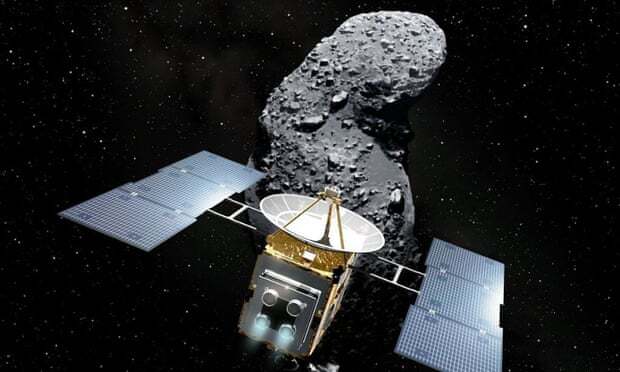25.01.2023
Rubble pile asteroid is almost as old as the solar system, a sign that it can withstand great shocks and may be difficult to destroy, research suggests

Tiny specks of dust from a “giant space cushion” almost as old as the solar system can provide new clues about how to avoid catastrophic asteroid collisions with Earth, research suggests.
Three tiny particles of dust – smaller than the diameter of a hair – collected from a 500-metre-long asteroid known as Itokawa show some of these space rocks are much older and tougher than previously thought.
The peanut-shaped Itokawa is classified as a potentially hazardous asteroid, one that could veer perilously close to Earth and could cause significant damage if it collided.
A study, published in the Proceedings of the National Academy of Sciences, has found that Itokawa formed more than 4.2bn years ago, making it 10 times older than solid asteroids of a similar size. The solar system, in comparison, is 4.57bn years old.
Itokawa is a rubble pile asteroid, which forms when solid asteroids collide and the resulting fragments assemble into new structures. They are composed of rocks, dust, pebbles and a void, and held together by the gravitational pull of their various components.
Solid asteroids are thought to have a lifespan of several hundred million years, and are gradually ground down by constant collisions.
“Such a long survival time for an asteroid is attributed to the shock-absorbent nature of rubble pile material and suggests that rubble piles are hard to destroy once they are created,” the study’s authors wrote.
“We were really surprised,” said Prof Fred Jourdan of Curtin University’s school of earth and planetary sciences, the study’s first author. “That’s really, really old, and I’m sure some of my colleagues are not even going to believe it.”
“It’s like a giant space cushion, and cushions are good at absorbing shock,” Jourdan told AFP.
Rubble-pile asteroids are so resilient to the constant battering they face that they are likely to be much more abundant than previously assumed. That might mean we need new ways to tackle such asteroids on a collision course with Earth, Jourdan said.
Nasa’s recent Dart test showed asteroids like Itokawa can be nudged off course, but that would probably require a lead time of several years.
An asteroid just weeks from colliding with Earth would require a different approach, and Jourdan argues a nuclear blast might be needed if an asteroid were detected too late for a direct impact deflection.
“It’s not ‘Armageddon’-style,” blowing it up, he says, referring to the 1998 sci-fi movie. “The shock wave should push the asteroid out of the way [without destroying it].”
It is a far-reaching conclusion to draw from such tiny specks of dust, but each particle is analysed at the atomic level.
The team analysed crystal structures in the samples, looking for deformations caused by the impact that created Itokawa. They dated the samples by measuring the decay of potassium into argon.
“We can get big stories like that out of [something] very, very small, because those machines, what they’re doing, is the measuring and counting of atoms,” Jourdan said. “Every grain has its own story to tell.”
The three samples of Itokawa dust were originally collected by the Japanese Space Agency’s Hayabusa 1 probe in 2005.
The samples were returned to Earth five years later. Scientists have been analysing them, along with hundreds of other particles from Itokawa, for clues ever since.
Quelle: The Guardian
